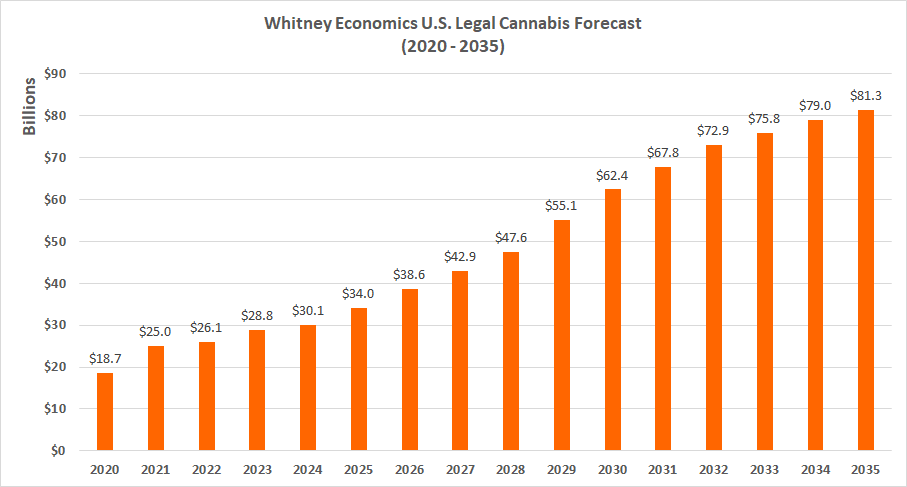Zinger Key Points
- Whitney Economics lowered its 2025–2030 U.S. cannabis market forecast by $21.1 billion.
- High taxes, oversupply and product substitutes are key factors dragging down revenue projections.
- States like California, Illinois and Arizona saw the steepest drops in revised 2025 revenue estimates.
- China’s new tariffs just reignited the same market patterns that led to triple- and quadruple-digit wins for Matt Maley. Get the next trade alert free.
Whitney Economics has sharply downgraded its long-term forecast for the U.S. cannabis market, slashing its 2025–2030 retail sales projection by $21.1 billion compared to estimates made just a year ago. The downward revision, revealed this week by the cannabis data and consulting firm, reflects persistent structural challenges in the industry, including punitive tax policies, lagging federal reform efforts and increasing pressure from substitute products.
According to founder Beau Whitney, the revised 2025 retail sales forecast now stands at $34.0 billion, up 13.1% from an estimated $30.1 billion in 2024—but still $1.2 billion lower than the firm's previous prediction. While this may seem like modest year-over-year growth, the larger trajectory through 2030 signals growing instability in the legal cannabis economy.

"Our updated forecast from this cycle has some pretty significant changes," Whitney said. "The forecast for 2025 was lowered from last year's by $1.2 billion, and the 2025–2030 legal retail cannabis forecast was reduced by $21.1 billion since our last update."
US Cannabis: A Fragmented Market With Mounting Pressures
The downward revision is not uniform across the map. In fact, outlier states such as New York and Maryland are bucking the national trend. Whitney Economics increased New York's 2025 forecast by $1.04 billion and Maryland's by $100 million, suggesting that emerging markets with robust regulatory traction can still offer growth.
Also read: Why Cannabis Accessory Brands Are Rushing To Expand Globally
But for most established cannabis states, the picture is far bleaker. California—once the crown jewel of legal cannabis—is now expected to bring in $606 million less in 2025 than previously projected. Illinois (—$497M), Arizona (—$425M), Colorado (—$183M), and Washington State (—$179M) also saw major forecast reductions.
The root causes are interconnected and systemic. "Lower prices, lower participation and more substitutes will result in lower revenues," Whitney said. "As such, we were forced to reduce our forecast. Both short-term and long-term growth are lower than we'd expected."
Oversupply And The Tax Burden
One of the most significant issues is price compression, driven largely by oversupply and unchecked cultivation capacity. Whitney Economics' analysis suggests that U.S. state regulators have authorized more cannabis production than the current demand—both legal and illicit—can absorb.
This glut of product is driving prices downward across the board, impacting not only operator profitability but also state tax revenues and, ultimately, the viability of legal businesses.
“Based on an analysis of the U.S., there is more supply authorized by state regulators than there is demand throughout the entire U.S., both legal and illicit," Whitney explained. "This is driving down prices to such an extent that it is impacting state tax revenues, operator profitability and is increasing business failures."
In addition, state and local tax policies actively disincentivize legal market participation. Consumers, particularly those who are price-sensitive, are willing to pay a slight premium for regulated products—but only to a point.
"A recent analysis of state and local cannabis prices indicated that states with high taxes are lagging behind other states in terms of the percentage of legal participation," Whitney noted.
The Rise Of Substitutes
Adding further complexity is the growing presence of hemp-derived THC products and a proliferation of unregulated alternatives. Consumers now have more options outside of licensed dispensaries—including gray-market hemp shops, interstate delivery and illegal operations.
"Given a choice of illicit suppliers, hemp suppliers and suppliers in other states, the consumer now has more options available to procure cannabis products outside of the traditional channels," Whitney said.
US Cannabis Sales Forecast Accuracy And The Road Ahead
Despite the significant downgrade, Whitney Economics emphasized that its previous 2024 forecast was 95.6% accurate, lending credibility to the methodology behind its new projections.
Still, the update paints a sobering picture of a legal cannabis industry that is struggling to fulfill its once-lofty promise. Unless federal reform accelerates, tax regimes are revised and supply becomes better aligned with demand, the economic reality of U.S. cannabis may remain far below expectations.
Photo: Shutterstock. Chart courtesy of Whitney Economics.
This content was partially produced with the help of AI tools and was reviewed and published by Benzinga editors.
Market News and Data brought to you by Benzinga APIs© 2025 Benzinga.com. Benzinga does not provide investment advice. All rights reserved.
Trade confidently with insights and alerts from analyst ratings, free reports and breaking news that affects the stocks you care about.
Cannabis is evolving—don’t get left behind!
Curious about what’s next for the industry and how to stay ahead in today’s competitive market?
Join top executives, investors, and industry leaders at the Benzinga Cannabis Capital Conference in Chicago on June 9-10. Dive deep into market-shaping strategies, investment trends, and brand-building insights that will define the future of cannabis.
Secure your spot now before prices go up—this is where the biggest deals and connections happen!